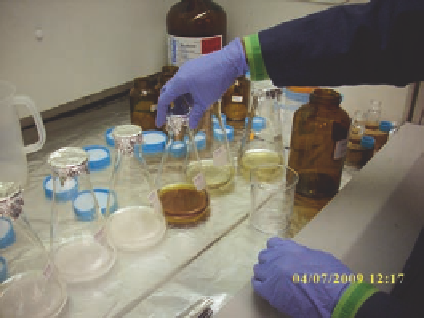Geology Reference
In-Depth Information
11.2. Sample Preparation
Organic solvent extraction in the
laboratory.
Photo Courtesy of Alpha Analytical Laboratory, Mansfield, Massachusetts, 2009.
Collection
T
he collection of coal and coal-tar samples for the analysis of semivolatile hydrocarbons is fairly simple. The
sample preparation and analysis can be completed with as little as about 5 g of sample; however, a nominal sample
size of ~100 g ensures the complete analysis by multiple methods including replicates, if needed. The conventional
sample container is a 4 oz (118.25mL) wide mouth amber jar with Teflon-lined cap that is devoid of organic
residues (US Environmental Protection Agency (USEPA), 2003). The samples are labeled with a unique sample
identity that often includes a code for the site, location, and depth interval. The samples are wrapped in packing
material (e.g., bubble wrap) and shipped to the hydrocarbon laboratory. Coal and coal tar do not require special
preservation; however, soil samples are commonly chilled to 2
-
6°C with ice that is sealed in a plastic bag. A chain
of custody is commonly completed to assure that the sample collection information (e.g., sample identities, date
and time of sampling, field team names, required testing methods, and custodial authority signature) is commu-
nicated to the laboratory. Upon receipt, the laboratory inspects the samples for damage during shipment and sample
preservation integrity, if applicable.
Extraction
S
amples of coal are extracted using a procedure developed for the extraction of semivolatile hydrocarbons
from highly sequestered soil and sediment (NOAA, 1993). The sample is initially subjected to particle size
reduction with mortar and pestle or equivalent to the approximate consistency of sand. Unless previously
determined, approximately 5 g of coal is weighed in an aluminum-weigh boat on an electronic balance
(
+0
.0001 g). After baking at 105°C for a minimum of 4 hours, the sample is re-weighed and percent moisture
determined by difference. A second aliquot of coal (~10 g) is placed in a solvent rinsed glass extraction vessel
(8 oz jars with Teflon-lined caps). An equal mass of anhydrous sodium sulfate (Na
2
SO
4
) is added to remove
residual moisture. The sample is spiked with a mixture of surrogate compounds that demonstrate the sample
extraction efficiency. Thirty to sixty milliliters (mL) of DCM are added on top of the spiked and dried sample.
The vessel is sealed and agitated on a shaker table for a minimum of 12 hours. The first extract is decanted
through a powder funnel containing anhydrous Na
2
SO
4
and collected in an Erlenmeyer flask. The extraction
vessel is recharged with DCM (30
60mL) and extracted a second time on the shaker table for at least 1 hour.
After decanting, the extraction vessel is recharged with DCM (30
-
-
60mL) and extracted a third time on the
shaker table for at least 1 hour. The combined DCM extract is concentrated by Kuderna Danish apparatus to
less than 10mL. The sample is brought up to exactly 10mL in a calibrated graduated cylinder. A small aliquot
is removed to determine the TEM.
Coal-tar samples are homogenized in the sample collection container with a laboratory spatula. Approximately 2 g
are transferred to a dilution vessel (10mL scintillation vial or equivalent) with Teflon-lined cap. Approximately
4mL of DCM are added to the vial. The vessel is capped and shaken by hand, votexed, or sonnicated for ~2
5
minutes. The sample is filtered through a power funnel containing anhydrous Na
2
SO
4
that drains into a 10 mL
-




